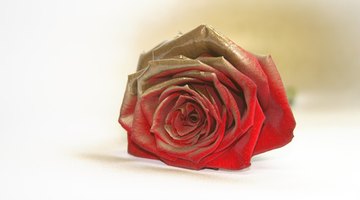Tips to Fix Spray Paint
Spraying gives a much smoother finish than painting with a paintbrush, but many things can go wrong in the process of forcing paint through a tiny nozzle under pressure.

If the consistency of the paint, the air pressure or the nozzle aperture are improperly adjusted, the result can be dripping and sagging, or a dusty, mottled finish. Following a few guidelines can help get the best results.
Paint Consistency
In order for paint to flow uniformly from the nozzle of a spray gun, it must be the right consistency. If the paint is too thin, too much will come out and it will form a watery surface that will drip and separate. If it is too thick, not enough will come out and it will spatter and form a bumpy, mottled surface. Check the directions for thinning the paint you are using, and use the thinner or reducer that is recommended, because some thinners evaporate more quickly than others. It's always a good idea to test the spray pattern before you begin painting to make sure it fans out evenly and creates a wet surface of paint that doesn't run.
Spraying Technique
Many problems in a spray finish are created by improper spraying techniques. Always hold the sprayer a uniform distance from the surface without arcing away at the ends. Keep the gun moving steadily and overlap about half the width of the spray pattern on each pass. Don't stop and dwell on areas that seem to be "hungry," because this is a sure way to create drips. Come back and touch up these areas after the paint has flashed. If the surface is too thick and the paint begins to run, hold the gun further back or move it more quickly. In the same way, if the surface is dusty or mottled, hold the gun closer or move it more slowly.
Fixing Defects
Most problems on a sprayed surface can be corrected with sandpaper and more coats of paint. It is important, though, to wait until all the paint, including drips, is completely dry before you try to fix anything. If you try to sand wet paint or lacquer, or you attempt to remove defects with thinner, you will create a mess that may require removal of the paint to clean up.
Sand the dry surface with 220-grit or finer sandpaper, and work especially hard on drips and orange peel to blend these into the rest of the surface. If these defects are severe, it may take several more coats to build up the surface enough for them to disappear.
If your clear lacquer is turning white as it dries, a condition called blushing, reduce the humidity in the room with a dehumidifier before you re-spray. Once the excess moisture in the air is gone, a new coat of lacquer should eliminate blushing.
References
Writer Bio
Chris Deziel has a bachelor's degree in physics and a master's degree in humanities. Besides having an abiding interest in popular science, Deziel has been active in the building and home design trades since 1975. As a landscape builder, he helped establish two gardening companies.
Photo Credits
- red rose sprayed with gold paint image by ennavanduinen from Fotolia.com
- red rose sprayed with gold paint image by ennavanduinen from Fotolia.com
More Articles


